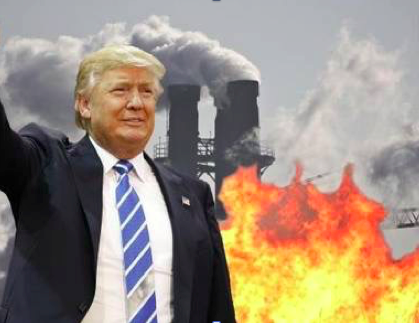Trump’s climate decision dangerous for the US and the world

June 1st, 2017
President Trump tweeted late on Wednesday evening that be will be announcing his decision on whether or not the US will withdraw from the Paris Climate Agreement today at 8PM Irish time.
Unfortunately, and as expected, he announced his decision to withdraw the US from the Agreement which aims to limit global average temperature to within 2°C above pre-industrial levels and combat the unavoidable impacts on people and the Earth.
Under Obama, the US had committed to reducing carbon emissions by 26-28 per cent by 2025. Now, the US will join only 2 other countries – Nicaragua and Syria – as non-participants in the global deal.
So from a procedural point of view how will the US’s withdrawal proceed? And more importantly, what are the most likely consequences for the US and the world?
Two withdrawal options
Article 28 of the Agreement allows countries to withdraw from the third year after the Agreement entered into force, which would be November 2019 for the US. The withdrawal would also not take effect for another year. So the earliest the US withdrawal would be effective is November 2020.
The other scenario is that the US withdraws from the 1992 United Nations Framework Convention on Climate Change, which necessarily means withdrawing from the Paris Agreement. This could be effective in one year.
Consequences of US withdrawal
One of the worse possible consequences of the US withdrawal from the Paris Agreement is that it could discourage other nations from taking further steps to limit their own emissions, thereby hindering efforts to reduce global emissions. The US withdrawal could also cause diplomatic strain and damage relationships with other countries.
Todd Stern, former US special envoy on climate change under Obama, puts it bluntly in a recent article in the Atlantic stating that “the President’s exit from Paris would be read as a kind of ‘drop dead’ to the rest of the world”.
Withdrawal could also result in the US being left behind in the low-carbon energy transformation. This transition is already underway and China and Europe would likely take primary roles.
China currently accounts for almost 50% of the world’s new solar energy capacity and the US risks falling behind and losing valuable US jobs in the wind and solar energy sectors. The economic importance of committing to the Paris Agreement is recognised by many US industries and companies.
Sixty-nine of 500 US Fortune 500 companies, including Walmart, ExxonMobil, and Chevron, have stated their support for the Paris Agreement. Over 1000 US companies have signed the Business Backs Low-Carbon USA statement urging the US to stay in the Agreement. Elon Musk, CEO of Tesla, has said he will withdraw for White House advisory councils if President Trumps withdraws.
In an interview in Business Insider UK John Sterman, professor at MIT Sloan School of Management and senior advisor at Climate Interactive said that it is “not far-fetched to imagine a scenario where China…implements a carbon tax on all goods exported from the US”.
Further down the road, the US government could also leave itself open to expensive lawsuits taken by victims of climate change, on the basis that the US withdrawal from the Paris Agreement causes damage and requires compensation.
Carry on Regardless
Many US States and the some of the largest US cities will continue to tackle climate change and transform their energy portfolio regardless of what President Trump decides.
In December 2016, I attended the American Geophysical Union Fall Meeting in San Francisco – the largest meeting on Earth and space sciences in the world. The Governor of California, Jerry Brown, gave a keynote speech and in it he responded to Trumps threat to stop satellite collection of climate data by saying “California will launch its own damn satellites”.
Many US states have invested heavily in clean energy technologies and are proceeding with their energy transformation. Wind and solar energy made up two-thirds of new electric energy capacity in the US last year.
Twelve US cities, representing 25 per cent of the US population, are part of the global C40 Climate Leadership Group.
Will the pressure change Trump’s mind?
With pressure piling from global leaders, environmental charities, scientists, Big Business, Democrats, Republicans and even family members, will Trump rethink his decision to enact one of his pre-election promises?
Ultimately, whether the US are in or out of the Paris Agreement, the new US administration will likely continue making damaging changes to US science, environmental and natural heritage policy.
[x_author title=”About the Author”]







